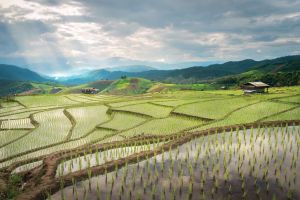This report examines the urgent challenges created by water scarcity and the impact on food security.
Introduction
Successful, sustainable water management in agriculture is imperative to achieve the food and nutrition security goals of a rapidly growing, urbanizing world.
Key Findings
The world is running out of clean, fresh water to feed—and nourish—a growing global population. Approximately 2.4 billion people—more than one-third of the global population—currently live in water-scarce regions, and projections indicate that by 2050 over one-half of the world’s population could be at risk due to water stress. At the same time, global demand for water will continue to increase, driven by population growth, rising consumption, urbanization, and energy needs.
The stakes are high for protecting and effectively managing this vital resource, as increasing water scarcity threatens to undermine the progress that has been made on global food and nutrition security. Failure to treat water as a strategic, valuable, and limited resource will accelerate water insecurity, even for historically water-secure populations, and may threaten the economic and political security of nations, including the United States.
Agriculture depends on a reliable source of water, which will be severely tested by changing climate patterns, unpredictable water supplies, and increased demand for diverse, nutritious diets. Smallholder farmers, who largely rely on rainfall for their water supply, are at the greatest risk of total crop failure in the face of these challenges. Yet if they can manage water effectively, these farmers could be well positioned to produce the high-value crops needed to meet consumer demand and lift themselves out of poverty.
With the potential for severe economic, political, and humanitarian consequences, bold action and a commitment from all stakeholders is needed to address this critical issue. A combination of careful management strategies, technological innovations, investments, and policies around water are imperative to advance a sustainable, resilient global food system in the face of increasing water scarcity. In partnership with national governments, the private sector, and civil society, the United States must continue to lead in these efforts. With thoughtful planning and a commitment to sustainability, it will be possible to meet the water and food demands of current generations—while laying the groundwork for a nourishing food system in the future.
Competition for Water
Water touches every aspect of our lives: food, health, environment, industry, and leisure. The competition for water resources is increasing between people and the natural environment as well as between cities and rural areas. Adding to this pressure, rising incomes are increasing demand for diverse, nutritious diets—including fruits, vegetables, legumes, nuts, healthy oils, and animal-source foods—which require more predictable supplies of water to produce at a time when changing climate patterns are making these supplies even less predictable.
By 2050 the global population is expected to increase to 9.8 billion, with 86 percent living in less developed countries and 70 percent living in rapidly growing urban areas. Farmers will need to improve their food production capacity to meet the needs of the growing populace, while expanding urban areas will also demand more water from a steadily decreasing supply. Global demand for water is generally projected to increase by 30 to 50 percent by 2050.
The fresh water necessary to produce crops and livestock accounts for the largest percentage of water usage among all sectors (71 percent), followed by industrial use (20 percent), and then domestic uses, including drinking water and sanitation (9 percent). Agriculture is expected to remain the largest user of freshwater resources in all regions in the foreseeable future, despite rapidly growing industrial and domestic demand. Competition for water among its many users is only going to intensify.
Threats to Food and Water Security
Intensifying sectoral competition and water scarcity problems—combined with declining reliability and quality of water supplies and increased degradation of ecosystems—are major challenges to future food and nutrition security. Greater variability in precipitation and increases in temperature will disrupt agricultural production, further threatening water, food, and nutrition security. These impacts will likely be felt most intensely in regions with the least resources to adapt to it.
Agricultural production in low- to middle-income countries is more vulnerable to adverse weather shocks due to lower coping capacity. Expanding access to sustainable irrigation methods can increase both productivity and climate resilience: while only 20 percent of all cultivated land is irrigated, this land accounts for about 40 percent of agricultural production. But irrigation also has costs and environmental impact if poorly managed, including overuse, groundwater depletion, soil degradation, and increased vulnerability.
As nonagricultural demand for water increases, water will be increasingly transferred from use for irrigation to other uses in many regions. This will create the potential for conflict as well as the loss of farm production and income, especially among smallholder farmers. The reliability and quality of both agricultural and nonagricultural water supplies will decline without significant improvements in water governance, management strategies, policy, and investment.
Strategies to Move the World Toward Greater Water, Food, and Nutrition Security
Successful, sustainable water management in agriculture is imperative to achieve the food and nutrition security goals of a rapidly growing, urbanizing world. Several existing strategies can be used to address the challenge posed by increasing water scarcity. These include:
- Improving overall water resource governance through institutions that are transparent, accountable, efficient, responsive, sustainable, and geographically contextualized;
- Allocating water more efficiently through water rights, regulations and quotas, water pricing, water trading, and subsidy reform;
- Improving crop and livestock productivity per unit of water and land through agricultural research, development, technology, extension, and financing;
- Shifting diets and diversifying agriculture to reduce the demand for water; and
- Increasing the supply of managed water and expanding the irrigated area through investment in infrastructure.
In addition, expanding urban and periurban agriculture and focusing on effective international agricultural trade policies, including trade in “virtual” water, will further support water productivity. Ensuring that these solutions reach smallholder farmers and that women and girls are empowered in the process is not only essential to increasing water productivity but will improve livelihoods and contribute to greater water, food, and nutrition security.



